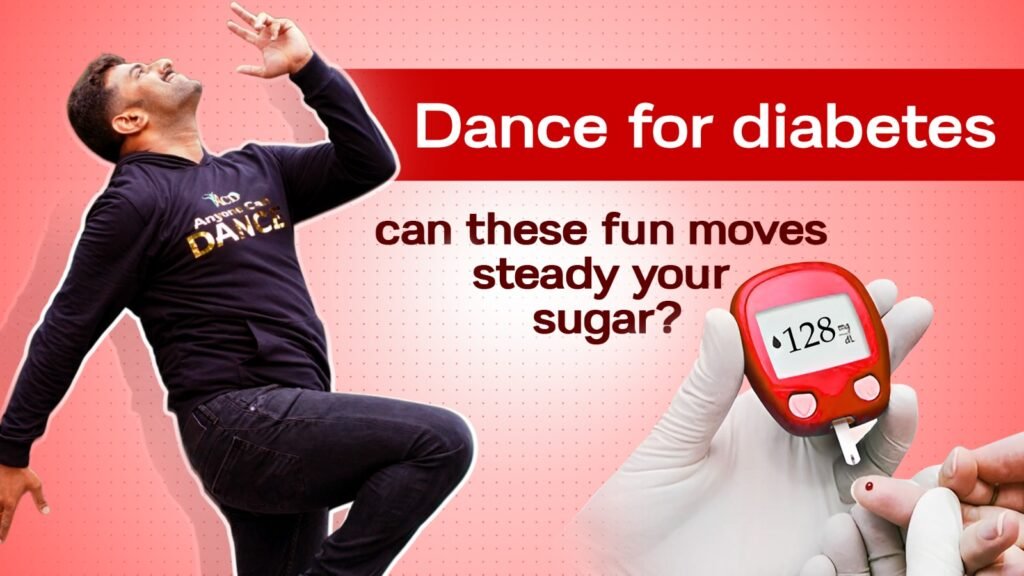
Introduction: The Sugar Struggle:
Diabetes is no longer just a chronic condition—it’s a global epidemic. According to the World Health Organization, over 422 million people worldwide live with diabetes, with type 2 diabetes being the most common and preventable form. What if managing blood sugar didn’t have to mean fear, restriction, or endless medications? What if it could be rhythmic, liberating, and even fun?
Enter dance.
Why Dance is a Game-Changer for Diabetes
1. Improves Insulin Sensitivity
Dance involves large muscle groups—legs, arms, core—which helps muscles absorb glucose without relying on insulin. According to a study in the Journal of Physiological Anthropology (2015), aerobic dance significantly improved insulin sensitivity and glucose uptake in pre-diabetic adults.
2. Lowers Blood Sugar Spikes
Just 10 minutes of moderate dancing after meals can reduce post-meal blood glucose spikes. A 2020 study published in Diabetes Care showed that postprandial physical activity, especially moderate rhythmic movement like dance, improved glucose levels significantly compared to sedentary control groups.
3. Promotes Weight Loss and Fat Reduction
Excess weight, especially belly fat, increases insulin resistance. Dance burns 200–400 calories per 30-minute session and is more sustainable than traditional workouts. A meta-analysis in Obesity Reviews found that Zumba-style dance led to meaningful weight loss in overweight adults.
4. Reduces Stress and Cortisol
Stress raises blood sugar. Dance lowers cortisol and boosts endorphins, according to Frontiers in Psychology (2014). Less stress = more stable sugar levels.
5. Improves Cardiovascular Health
People with diabetes are at higher risk of heart disease. Dance not only lowers blood sugar but also improves VO₂ max and reduces blood pressure, making it a holistic cardio workout.
Scientific Evidence at a Glance
- Obesity Facts (2015): Aerobic dance programs lowered HbA1c by 0.5–1.0% in 12 weeks.
- Diabetes Research and Clinical Practice (2018): Participants in structured dance programs had improved fasting glucose and lower triglyceride levels.
- Journal of Aging and Physical Activity (2016): Older adults with type 2 diabetes improved balance, mobility, and sugar control through weekly dance therapy sessions.
Real-Life Example: Ramesh’s Story
Ramesh, 52, was newly diagnosed with type 2 diabetes and placed on medication. He joined a 6-week dance wellness challenge, dancing for just 15 minutes post-lunch daily. Within two months, his fasting blood sugar dropped from 148 to 109 mg/dL, his weight reduced by 4 kg, and most importantly—he looked forward to the movement.
How to Begin: Dance Protocol for Blood Sugar Control
- When to Dance: 15–30 minutes after meals.
- What to Do:
- –3 mins warm-up (shoulder rolls, step touch)
- –10 mins mid-tempo dance (bhangra, freestyle, salsa)
- –2 mins cool-down with deep breathing
- –How Often: At least 5 days a week–
Tips for Success
- Track your blood sugar before and after dancing for real-time feedback.
- Wear supportive shoes and dance on a safe surface.
- Create a playlist that motivates joy and movement.
Supportive Practices
- Stay hydrated
- Eat balanced meals with fiber and protein
- Sleep 7–8 hours to optimize glucose metabolism
Conclusion: Your Blood Sugar Loves Music
Dance is more than movement—it’s medicine. It’s the only prescription that manages sugar, reduces fat, lifts your mood, and makes you smile—all in one go. So instead of counting steps or calories, count beats. And let every move you make be a step toward healing.
Citations
- World Health Organization. Diabetes facts and statistics.
- Journal of Physiological Anthropology (2015). Aerobic dance and insulin sensitivity.
- Diabetes Care (2020). Impact of post-meal physical activity on glucose levels.
- Obesity Reviews. Effects of dance interventions on weight loss.
- Frontiers in Psychology (2014). Stress reduction through dance movement therapy.
- Obesity Facts (2015). Aerobic dance reduces HbA1c in diabetic patients.
- Diabetes Research and Clinical Practice (2018). Structured dance and blood lipid profiles.
- Journal of Aging and Physical Activity (2016). Dance therapy in elderly diabetic adults.
